Objective tinnitus is a rare but distinct form of tinnitus where both the patient and healthcare provider can hear unusual sounds in the ear. Unlike its more common counterpart, subjective tinnitus, these sounds have a physical source within the body and can often be measured or observed by medical professionals.
This condition can significantly impact a person's quality of life, but understanding its causes and available treatments is crucial for effective management. Let's explore the key aspects of objective tinnitus and how it can be addressed.
Understanding Objective Tinnitus and Its Causes
Objective tinnitus occurs when actual sounds are generated by structures near the ear or by vascular abnormalities. These sounds can include clicking, pulsing, or rushing noises that correspond to blood flow, muscle contractions, or other physiological processes.
Common Causes
Several conditions can lead to objective tinnitus:
- Blood vessel abnormalities
- Muscle spasms in the middle ear
- Eustachian tube dysfunction
- Palatal myoclonus
- Vascular tumors near the ear
- Arteriovenous malformations
Diagnosis and Medical Evaluation
Diagnosing objective tinnitus requires a thorough medical examination and various diagnostic tests. Healthcare providers typically use specialized equipment to detect and measure the sounds, confirming their objective nature.
Diagnostic Procedures
Common diagnostic tools and methods include:
- Otoscopic examination
- Auscultation with a stethoscope
- Imaging studies (MRI, CT scan)
- Vascular studies
- Neurological examination
- Audiological testing
Treatment Approaches and Management
Treatment for objective tinnitus focuses on addressing the underlying cause rather than just managing symptoms. The approach varies depending on the specific condition causing the tinnitus.
Medical Interventions
Treatment options may include:
- Surgical correction of vascular abnormalities
- Medication to address muscle spasms
- Treatment of underlying conditions
- Blood pressure management
- Removal of tumors if present
- Specialized ear procedures
Prevention and Lifestyle Modifications
While not all cases of objective tinnitus can be prevented, certain lifestyle changes may help reduce risk factors:
- Regular blood pressure monitoring
- Maintaining healthy circulation
- Avoiding excessive caffeine and salt
- Regular exercise
- Stress management
- Regular medical check-ups
Frequently Asked Questions
What are the common causes and symptoms of objective tinnitus?
Objective tinnitus is commonly caused by blood vessel abnormalities, muscle contractions in the middle ear, and structural problems near the ear. Symptoms include clicking, pulsing, or rushing sounds that can be heard by both the patient and doctor, often synchronized with heartbeat or muscle movements.
How is objective tinnitus diagnosed, and what tests are typically used?
Diagnosis involves physical examination, listening with a stethoscope, imaging studies like MRI or CT scans, and specialized audiological tests. Doctors may also perform vascular studies to identify any blood vessel abnormalities.
What are the treatment options for objective tinnitus, and how effective are they?
Treatment options vary based on the underlying cause but may include surgery for vascular abnormalities, medication for muscle spasms, and specific treatments for identified medical conditions. The effectiveness depends on accurately identifying and successfully treating the root cause.
Can objective tinnitus be prevented, and what lifestyle changes can help reduce its risk?
While not entirely preventable, maintaining healthy blood pressure, regular exercise, and avoiding triggers like excessive caffeine can help reduce risks. Regular medical check-ups can also help identify potential issues early.
What is the difference between objective and subjective tinnitus in terms of diagnosis and treatment?
Objective tinnitus produces sounds that both the patient and healthcare provider can hear and has an identifiable physical cause. This differs from subjective tinnitus, which only the patient can hear. The diagnosis and treatment approaches vary accordingly, with objective tinnitus typically having more straightforward treatment options targeting the specific cause.




